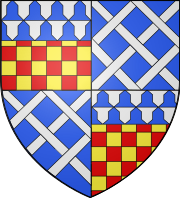| Baron Templemore | |
|---|---|
  Arms: Quarterly 1st & 4th, Chequy Or and Gules (for Chichester); 2nd & 3rd, Azure, fretty Argent (for Etchingham). Crest: A Heron wings expanded proper, holding in the beak an Eel Argent. Supporters: Dexter: A Wolf Gules ducally gorged with a Line reflexed over the back Or. Sinister: An Heraldic Tiger Sable, ducally crowned Or. | |
| Creation date | 10 September 1831 |
| Created by | King William IV |
| Peerage | Peerage of the United Kingdom |
| First holder | Arthur, 1st Baron Templemore |
| Present holder | Patrick, 8th Marquess of Donegall |
| Heir apparent | James, Earl of Belfast |
| Status | Extant |
| Motto | INVICTUM SEQUITUR HONOR (Unsought honour follows) |
| Since 1975 a subsidiary title of the Marquess of Donegall | |
Baron Templemore, of Templemore in the County of Donegal, is a title in the Peerage of the United Kingdom, [1] since 1975 a subsidiary title of the Marquessate of Donegall. It was created on 10 September 1831 for Arthur Chichester, Member of Parliament for Milborne Port and County Wexford. He was the son of Lord Spencer Stanley Chichester, third son of The 1st Marquess of Donegall (see Marquess of Donegall for earlier history of the Chichester family). Lord Templemore's son, the second Baron, and grandson, the third Baron, both served as Deputy Lieutenants of County Wexford. The latter was succeeded by his eldest son, the fourth Baron. He served as the Government Chief Whip in the House of Lords between 1940 and 1945. He was succeeded by his second but eldest surviving son, the fifth Baron. In 1975 he succeeded his kinsman as seventh Marquess of Donegall. For further history of the titles, see Marquess of Donegall.
Contents
Two other members of this branch of the Chichester family may also be mentioned. The Honourable Augustus George Charles Chichester (1822–1896), second son of the first Baron, was a Lieutenant-General in the 77th Foot. The Honourable Sir Gerald Henry Crofton Chichester (1886–1939), second son of the third Baron, was private secretary to Queen Mary between 1935 and 1939.
Despite the geographical designation "Templemore in the County of Donegal", in 1831 the civil parish of Templemore was entirely in County Londonderry rather than in neighbouring County Donegal. [2] The name "Templemore" originally designated the medieval cathedral of Derry, and later the parish west of the River Foyle served by the cathedral. [2] A 1613 charter included the portion of the parish nearest the renamed city of Londonderry within the city's northwest liberties and the new County Londonderry. [2] Subsequently, the County Donegal portion of Templemore was made into separate parishes (Muff, Burt, and Inch). [2]
